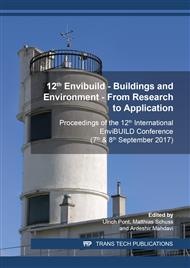p.264
p.273
p.282
p.292
p.303
p.311
p.319
p.327
p.335
LCA-Based Design Support for a Senior Citizens’ Residence
Abstract:
This paper reports on a project for a senior citizens’ residence in the vicinity of Trento, Italy. The project constitutes the major part of a Master’s thesis in Architectural Engineering, developed at the University of Trento in Italy and at TU Vienna in Austria. The work entails a full account of environmental impacts during the life cycle of the building through LCA (Life Cycle Assessment). Furthermore, as buildings' end of life scenarios are insufficiently considered in most conventional LCA studies, the present contribution attempts to pursue a “cradle to cradle” approach (exploring a closed-loop flow of materials, energy, and resources) and to emphasize that the consequences of the choices made at the early stage of the design phase are critical for the subsequent stages of construction, use, maintenance, and end of life.The work consists of two parts. The first part relating to the architectural project involves careful consideration of the local characteristics of the site according to bioclimatic studies. In the second part, a comparative LCA study of different timber constructions and energy system options is presented, followed by a global LCA of the project. This aims at the estimation of the impacts of construction and end of life. Thereby, different possibilities are explored for reusing and recycling materials, such that disposal and incineration could be reduced as much as possible. Thus, the relative significance of different stages of the building construction, operation, and decommissioning can be explored.In conclusion, the paper offers a number of theoretical reflections on uncertainty analysis in LCA, addressing input assumptions (availability and quality of data) as well those regarding normalization and weighting factors. Thereby, the aim is to contribute to efforts toward a more pervasive application of the LCA methodology in the building design and delivery process.
Info:
Periodical:
Pages:
303-310
Citation:
Online since:
January 2019
Keywords:
Price:
Сopyright:
© 2019 Trans Tech Publications Ltd. All Rights Reserved
Share:
Citation:


